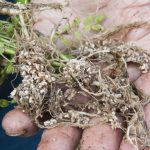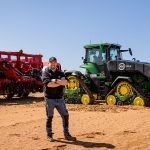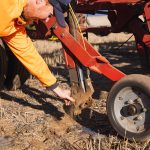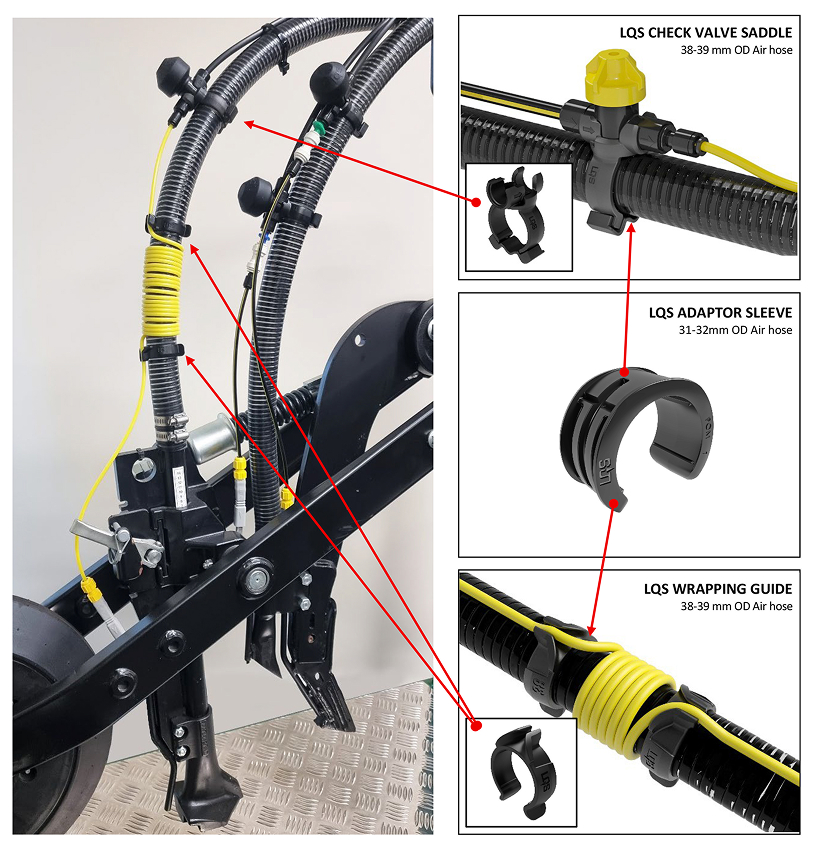Cottoning onto Liquid Fertilisers
Farmer and agronomist Dan Skerman was sold on the benefits of liquid fertilisers after seeing firsthand how his customers’ crops responded.
Dan farms with his parents Ross and Merryll, brother Josh and cousin Luke, near Dalby, Qld, where they grow a mix of summer and winter grain and legume crops, including sorghum, mung bean, wheat, barley and chickpeas on 2000 hectares. They also plant between 40 -100 ha of irrigated cotton and up to 500 ha of dryland cotton each season.
| ABOUT |
|---|
- WHO: Dan Skerman
- LOCATION: Dalby, Queensland
- INPUTS: 100-200 L/ha UAN, Loveland Liquid Boost, Freeze Dried Inoculant.
- PROPERTY: 2000ha cropping enterprise, cotton, wheat, chickpeas, sorghum and mung beans
- EQUIPMENT: Liquid Systems (SA) LQS176 Pump Module mounted on Cat Challenger Tractor, and 3 LQS Stacker Kits on 3 different bars
| KEY OUTCOMES |
|---|
- Simplified seeding operations for a wide range of crops
- Stronger early crop establishment
- Improved nitrogen use efficiency
- Improved and easier legume inoculation
Drawing on this knowledge the Skerman family made the switch to liquids over 10 years ago and in the process achieved efficiencies and cost savings in their cropping enterprises.
Efficient Setup
With this diverse mix of crops needing different planting equipment, the Skerman’s opted to mount a second-hand Liquid Systems LQS176 Pump Module on a Cat Challenger tractor along with two 1100 litre saddle tanks, when making the switch to liquids.
With their seeding bars now set up for liquids using Liquid Systems ‘Stacker’ Distribution Kits, they can simply hook up the module connector hose to the bars and be ready to go.
“It just makes planting time easier, and the summer crop planter works better not having to pull the air seeder. We found the “plug and play” nature of the Liquid Systems diaphragm pumps simpler to use than non-flow systems and you know you are putting out the right rate,” Dan said.
In some seasons it can be chalk and cheese, with vigour and establishment, and you only need it to pay off one in every few years when you end up with a healthier stronger plant to get through the tough seasons
Two summer planters are set up for liquid pop up, one for doing dryland cotton and one for irrigated cotton. Liquid goes down through a Keeton seed firmer into the furrow. Applying 10-20 L/ha of Loveland Liquid Boost with water -40 L/ha total at planting.
Dan said “We quite often get a starter response, but it doesn’t always go through to yield just because of the seasons. But we usually get a visually healthier, stronger plant.”
The Skerman’s continue to apply the liquid pop-up as Dan has seen the benefits demonstrated via side-by-side comparisons with and without starter fertiliser, either liquid or granular.
“In some seasons it can be chalk and cheese, with vigour and establishment, and you only need it to pay off one in every few years when you end up with a healthier stronger plant to get through the tough seasons,” Dan said.
Efficient legume inoculant
Dan uses a third planter to water inject freeze-dried inoculant onto the seed in the furrow, for pulses such as chickpeas and mungbeans and is impressed by the efficiency of the process.
Not having to pre-inoculate the seed in itself is so neat to me. Once you’ve done it, you’re like, why the hell was I doing it the other way.
This planter is towed behind the air seeder so that a granular starter fertiliser can be sown at the same time.
 Image Above: Cat Challenger Tractor with the LQS176 Pump Module, with two 1100 litre saddle tanks. Pulling the bar for water inject freeze-dried inoculant onto Chickpeas.
Image Above: Cat Challenger Tractor with the LQS176 Pump Module, with two 1100 litre saddle tanks. Pulling the bar for water inject freeze-dried inoculant onto Chickpeas.
Cotton top-up
An in-row cultivator is used to side-dress cotton when plants are 20-30 cm high, and at the 10-12 node stage. The cultivator is set up so once hitched to the tractor with the LQS176 Pump Module they can apply around 150 to 200 L/ha of UAN. The liquid stream is placed 25-40 cm away from the plant at the side of the furrow hill.
“Most people go through and cultivate the rows to get weeds out or clean furrows out to run irrigation water. But at the same time, we will apply more nitrogen on just to split it up and to gain better efficiency instead of putting it all on before planting.”
Dans says for irrigated cotton in his region 70-50% of the crops’ nitrogen needs are applied pre-plant over winter, with additional N generally applied in early summer. “
“It’s pretty inefficient and we are losing a lot. We are trying to put more on in crop but you can’t always get around it all and often you’re meant to be irrigating,” he said.
But our liquid system gives us more precision – every seed gets the same amount of fertiliser, which is really important for improving yields in row crops such as sorghum.
Image Above: Cat Challenger Tractor with the LQS176 Pump Module, with two 1100 litre saddle tanks hitched to the 9m planter on 60” spacings for irrigated Cotton applying Liquid Boost.
Image Above: Cat Challenger Tractor with the LQS176 Pump Module, with two 1100 litre saddle tanks hitched to the 12m planter for dryland Sorghum applying Liquid Boost.
Liquids in-furrow
Dan is keen to see more growers adopt liquid fertilisers and believes they are a no-brainer but says the current price and the lack of supply and storage infrastructure in his region are significant barriers to growers switching to liquids.
Overall, Dan believes liquid fertilisers provide better establishment and healthier plants, with the liquid nutrients in a form that is more available to the plant.
I’ve seen one example in double skip cotton where one grower was using liquids, the bloke right over the fence, wasn’t, with the same history, planted on the same day. The liquid fertiliser treated crop really stood out and was just a lot more even- that was the only thing I could put it down to.
Pleased with the quality of the LQS176 module, Dan is happy to recommend Liquid Systems to other growers.
“The service from the Liquid Systems team was great- they helped us troubleshoot a few things when we were setting up and when we needed to replace some parts on our 2nd hand unit. It’s all been done for you and is built to last,” Dan said.
Image Above: Skermans second hand bought LQS176 Module. It is an older version than the new modules today.
Image Above: LQS Stacker Distribution Kits are set up on 3 different bars.
Get a Quote
"*" indicates required fields










